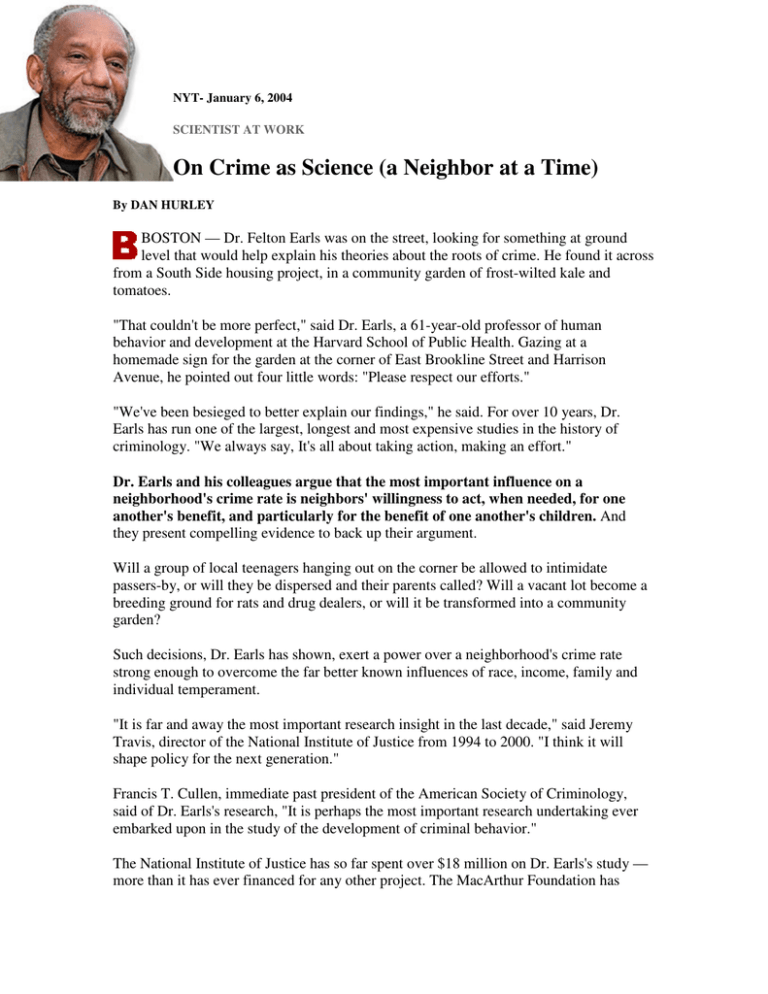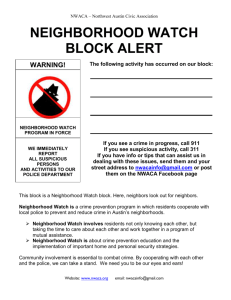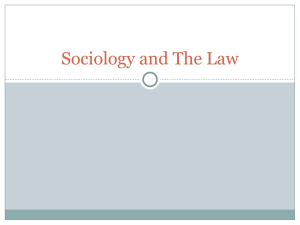On Crime as Science (a Neighbor at a Time)
advertisement

NYT- January 6, 2004 SCIENTIST AT WORK On Crime as Science (a Neighbor at a Time) By DAN HURLEY BOSTON — Dr. Felton Earls was on the street, looking for something at ground level that would help explain his theories about the roots of crime. He found it across from a South Side housing project, in a community garden of frost-wilted kale and tomatoes. "That couldn't be more perfect," said Dr. Earls, a 61-year-old professor of human behavior and development at the Harvard School of Public Health. Gazing at a homemade sign for the garden at the corner of East Brookline Street and Harrison Avenue, he pointed out four little words: "Please respect our efforts." "We've been besieged to better explain our findings," he said. For over 10 years, Dr. Earls has run one of the largest, longest and most expensive studies in the history of criminology. "We always say, It's all about taking action, making an effort." Dr. Earls and his colleagues argue that the most important influence on a neighborhood's crime rate is neighbors' willingness to act, when needed, for one another's benefit, and particularly for the benefit of one another's children. And they present compelling evidence to back up their argument. Will a group of local teenagers hanging out on the corner be allowed to intimidate passers-by, or will they be dispersed and their parents called? Will a vacant lot become a breeding ground for rats and drug dealers, or will it be transformed into a community garden? Such decisions, Dr. Earls has shown, exert a power over a neighborhood's crime rate strong enough to overcome the far better known influences of race, income, family and individual temperament. "It is far and away the most important research insight in the last decade," said Jeremy Travis, director of the National Institute of Justice from 1994 to 2000. "I think it will shape policy for the next generation." Francis T. Cullen, immediate past president of the American Society of Criminology, said of Dr. Earls's research, "It is perhaps the most important research undertaking ever embarked upon in the study of the development of criminal behavior." The National Institute of Justice has so far spent over $18 million on Dr. Earls's study — more than it has ever financed for any other project. The MacArthur Foundation has spent another $23.6 million on the study, likewise the most it has spent, and money from other government agencies has brought the cost of the project to over $51 million so far. Dr. Earls came to his current work by a circuitous route that included one great leap. Born to working-class parents in New Orleans, he graduated from Howard University's College of Medicine and pursued a postdoctoral fellowship in neurophysiology at the University of Wisconsin. It was there that he met Dr. Mary Carlson, a neurophysiologist. They have been married for 31 years and are now collaborating on a project in Tanzania to promote the well-being of children who have lost their parents to AIDS. When they met, they were both aiming for a white-jacket career in the laboratory. In fact, back in April 1968, Dr. Earls spent 36 hours straight, alone for much of the time, in a soundproof room, mapping the responses of a cat's brain to various high- or lowfrequency sounds. When he emerged from his laboratory on the evening of April 5, the Wisconsin campus was in an uproar. Only then did he learn that Martin Luther King Jr. had been killed the day before. Having participated in rallies led by Dr. King, Dr. Earls says he reacted instantly. "I realized that I couldn't have a career in neurophysiology. I couldn't remain in a laboratory," he said. "King's death made me see that I had to work for society. My laboratory had to be the community, and I had to work with children because they represent our best hope." Six months later, he left Wisconsin and went to East Harlem to train as a pediatrician, then to Massachusetts General Hospital to train as a child psychiatrist, and finally to the London School of Hygiene for a degree in public health. His research is, in essence, about the health of communities, not just about crime. "I am concerned about crime," he said, "but my background is in public health. We look at kids growing up in neighborhoods across a much wider range than just crime: drug use, school performance, birth weights, asthma, sexual behavior." His study, based in Chicago, has challenged an immensely popular competing theory about the roots of crime. "Broken windows," as it is known, holds that physical and social disorder in a neighborhood lead to increased crime, that if one broken window or aggressive squeegee man is allowed to remain in a neighborhood, bigger acts of disorderly behavior will follow. This theory has been one of the most important in criminology. It was first proposed in an article published 20 years ago in The Atlantic Monthly, written by Dr. James Q. Wilson and George L. Kelling. The theory provided the intellectual foundation for a crackdown on "quality of life" crimes in New York City under Mayor Rudolph W. Giuliani. Today, "broken windows" policing is endorsed by police chiefs across the country, its proponents sought out for lectures and consulting around the world. But from the beginning, Dr. Wilson concedes, the theory lacked substantive scientific evidence that it worked. "I still to this day do not know if improving order will or will not reduce crime," Dr. Wilson, now a professor emeritus at the University of California, Los Angeles, recently said in a telephone interview. "People have not understood that this was a speculation." Testing "broken windows" was not the point of the Project on Human Development in Chicago Neighborhoods, the study planned and conducted by Dr. Earls and colleagues to unravel the social, familial, educational and personal threads that weave together into lives of crime and violence. Nonetheless the data gathered for it, with a precision rarely seen in social science, directly contradicted Dr. Wilson's notions. From June to October 1995, trained observers drove a sport utility vehicle at 5 miles per hour down every street in 196 carefully selected Chicago neighborhoods. As they drove, a pair of video recorders, one on each side of the S.U.V., recorded social activities and physical features: litter, graffiti, drug deals, public drinking, everything within the camera's view. When the researchers were done, 11,408 blocks had been observed and videotaped. Then the police records on homicide, robbery and burglary were pulled for each of these 196 neighborhoods, along with in-person surveys of 8,782 residents. In a landmark 1997 paper that he wrote with colleagues in the journal Science, and in a subsequent study in The American Journal of Sociology, Dr. Earls reported that most major crimes were linked not to "broken windows" but to two other neighborhood variables: concentrated poverty and what he calls, with an unfortunate instinct for the dry and off-putting language of social science, collective efficacy. "If you got a crew to clean up the mess," Dr. Earls said, "it would last for two weeks and go back to where it was. The point of intervention is not to clean up the neighborhood, but to work on its collective efficacy. If you organized a community meeting in a local church or school, it's a chance for people to meet and solve problems. "If one of the ideas that comes out of the meeting is for them to clean up the graffiti in the neighborhood, the benefit will be much longer lasting, and will probably impact the development of kids in that area. But it would be based on this community action — not on a work crew coming in from the outside." Boston's experience in the 1990's, he believes, demonstrates his point. "Right now there are about 35 homicides per year in Boston, down from 151 in 1991," he said. "It plummeted between 1996 and 1998. Many people attributed it to the Ten-Point Coalition, a group of black ministers who took to the streets to engage kids and work with other adults to develop after-school programs. "At the same time, they were also asking the kids to help them target the ringleaders who were going down to Maryland to buy weapons. And they were coordinating their activities with policemen. So through these ministers, there was an activation of large groups of adults and kids." Driving back from the community garden in the South End of Boston, Dr. Earls emphasized that the analysis of the findings of the Chicago study had only begun. The entire neighborhood study was repeated between 2000 and 2002, and a second study tracking the behavioral and medical development of some 7,000 children in those same neighborhoods from birth to age 25, was finished in December 2001. Dr. Robert J. Sampson of Harvard, Dr. Steven Raudenbush of the University of Michigan, Dr. Jeanne Brooks-Gunn of Columbia and Dr. Earls are now working together on papers that they expect to see published this year. "If we are to show that where you grow up is more important than your temperament or your I.Q. or your family, or even equally important, that is a major contribution to science," Dr. Earls said. "We're saying that community is important at a moment in science when many of the most dramatic findings are in genetics. If genetics plays a role, it's got to be a minor role, because the community effects are very robust." As important as the study's findings, Dr. Earls said, are the measurement tools developed to uncover them. "Newton's discovery of gravity was important because he was able to measure it and quantify it," he says. "What we are discovering around collective efficacy was not terribly obvious before we started to measure it with some precision." As for policy implications, Dr. Earls said that rather than focusing on arresting squeegee men and graffiti scrawlers, local governments should support the development of cooperative efforts in low-income neighborhoods by encouraging neighbors to meet and work together. Indeed, cities that sow community gardens, he said, may reap a harvest of not only kale and tomatoes, but safer neighborhoods and healthier children. Sampson R, Raudenbush SW, and Earls F. (1997). Neighborhoods and violent crime: A multilevel study of collective efficacy. Science, 277:918-924. Mirrored at Rutgers. Robert Sampson, Stephen Raudenbush, Systematic Social Observation of Public Spaces: A New Look at Disorder in Urban Neighborhoods, American Journal of Sociology, Volume 105 Number 3 (November 1999): 603–51. Mirrored at Rutgers.






